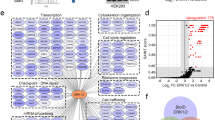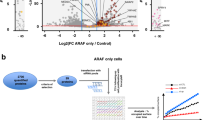Abstract
Normal cells undergo anoikis when they lose adhesion to or encounter an inappropriate extracellular matrix. By contrast, oncogenic signaling in tumor cells enables resistance to anoikis, a trait that contributes to tumor progression. The B-RAF serine-threonine kinase is mutated in multiple cancers and functions as an oncogene in melanoma. Previously, we demonstrated that B-RAF and downstream mitogen-activated protein/extracellular signal-regulated kinase kinase (MEK) signaling are necessary for protection from anoikis in mutant B-RAF-expressing melanoma cells. Regulation of Bcl-2 family members in melanoma and their role in B-RAF-mediated survival is poorly defined. Here, we provide evidence that B-RAF-MEK signaling protects against anoikis through alterations in two proapoptotic Bcl-2 family proteins: Bcl-xL/Bcl-2-associated death promoter (Bad) and Bcl-2-interacting mediator of cell death (Bim). B-RAF-MEK signaling regulates phosphorylation of the inhibitory serine-75 residue of Bad, and decreases Bad mRNA expression. RNA interference and overexpression experiments demonstrate that Bad contributes to the susceptibility of B-RAF-depleted cells to anoikis. Additionally, B-RAF-MEK signaling regulates the expression of BimEL, mainly through control of protein turnover. Increased BimEL levels induce apoptosis in suspended cells and are required for anoikis in B-RAF-depleted cells. Depletion of Bim together with Bad has an additive effect on protecting B-RAF knockdown cells from anoikis. Together, our data show that Bad and Bim are major B-RAF responsive proteins regulating apoptosis in melanoma cells.
This is a preview of subscription content, access via your institution
Access options
Subscribe to this journal
Receive 50 print issues and online access
$259.00 per year
only $5.18 per issue
Buy this article
- Purchase on Springer Link
- Instant access to full article PDF
Prices may be subject to local taxes which are calculated during checkout








Similar content being viewed by others
References
Akiyama T, Bouillet P, Miyazaki T, Kadono Y, Chikuda H, Chung UI et al. (2003). Regulation of osteoclast apoptosis by ubiquitylation of proapoptotic BH3-only Bcl-2 family member Bim. EMBO J 22: 6653–6664.
Amiri KI, Horton LW, LaFleur BJ, Sosman JA, Richmond A . (2004). Augmenting chemosensitivity of malignant melanoma tumors via proteasome inhibition: implication for bortezomib (VELCADE, PS-341) as a therapeutic agent for malignant melanoma. Cancer Res 64: 4912–4918.
Berenson JR, Yang HH, Sadler K, Jarutirasarn SG, Vescio RA, Mapes R et al. (2006). Phase I/II trial assessing bortezomib and melphalan combination therapy for the treatment of patients with relapsed or refractory multiple myeloma. J Clin Oncol 24: 937–944.
Bhatt KV, Hu R, Spofford LS, Aplin AE . (2007). Mutant B-RAF signaling and cyclin D1 regulate Cks1/S-phase kinase-associated protein 2-mediated degradation of p27Kip1 in human melanoma cells. Oncogene 26: 1056–1066.
Bhatt KV, Spofford LS, Aram G, McMullen M, Pumiglia K, Aplin AE . (2005). Adhesion control of cyclin D1 and p27Kip1 levels is deregulated in melanoma cells through BRAF-MEK-ERK signaling. Oncogene 12: 3459–3471.
Boisvert-Adamo K, Aplin AE . (2006). B-RAF and PI-3 kinase signaling protect melanoma cells from anoikis. Oncogene 25: 4848–4856.
Bouillet P, Zhang LC, Huang DC, Webb GC, Bottema CD, Shore P et al. (2001). Gene structure alternative splicing, and chromosomal localization of pro-apoptotic Bcl-2 relative Bim. Mamm Genome 12: 163–168.
Cheng EH, Wei MC, Weiler S, Flavell RA, Mak TW, Lindsten T et al. (2001). BCL-2, BCL-X(L) sequester BH3 domain-only molecules preventing BAX- and BAK-mediated mitochondrial apoptosis. Mol Cell 8: 705–711.
Conner SR, Scott G, Aplin AE . (2003). Adhesion-dependent activation of the ERK1/2 cascade is by-passed in melanoma cells. J Biol Chem 278: 34548–34554.
Cory S, Adams JM . (2002). The Bcl2 family: regulators of the cellular life-or-death switch. Nat Rev Cancer 2: 647–656.
Cowburn AS, Cadwallader KA, Reed BJ, Farahi N, Chilvers ER . (2002). Role of PI3-kinase-dependent Bad phosphorylation and altered transcription in cytokine-mediated neutrophil survival. Blood 100: 2607–2616.
Datta SR, Dudek H, Tao X, Masters S, Fu H, Gotoh Y et al. (1997). Akt phosphorylation of BAD couples survival signals to the cell-intrinsic death machinery. Cell 91: 231–241.
Davies H, Bignell GR, Cox C, Stephens P, Edkins S, Clegg S et al. (2002). Mutations of the BRAF gene in human cancer. Nature 417: 949–954.
Dong J, Phelps RG, Qiao R, Yao S, Benard O, Ronai Z et al. (2003). BRAF oncogenic mutations correlate with progression rather than initiation of human melanoma. Cancer Res 63: 3883–3885.
Eisenmann KM, VanBrocklin MW, Staffend NA, Kitchen SM, Koo H-M . (2003). Mitogen-activated protein kinase pathway-dependent tumor-specific survival signaling in melanoma cells through inactivation of the proapoptotic protein bad. Cancer Res 63: 8330–8337.
El Chami N, Ikhlef F, Kaszas K, Yakoub S, Tabone E, Siddeek B et al. (2005). Androgen-dependent apoptosis in male germ cells is regulated through the proto-oncoprotein Cbl. J Cell Biol 171: 651–661.
Frisch SM, Francis H . (1994). Disruption of epithelial cell–matrix interactions induces apoptosis. J Cell Biol 124: 619–626.
Fukazawa H, Noguchi K, Masumi A, Murakami Y, Uehara Y . (2004). BimEL is an important determinant for induction of anoikis sensitivity by mitogen-activated protein/extracellular signal-regulated kinase kinase inhibitors. Mol Cancer Ther 3: 1281–1288.
Fukazawa H, Noguchi K, Murakami Y, Uehara Y . (2002). Mitogen-activated protein/extracellular signal-regulated kinase kinase (MEK) inhibitors restore anoikis sensitivity in human breast cancer cell lines with a constitutively activated extracellular-regulated kinase (ERK) pathway. Mol Cancer Ther 1: 303–309.
Giancotti FG, Tarone G . (2003). Positional control of cell fate through joint integrin/receptor protein kinase signaling. Annu Rev Cell Dev Biol 19: 173–206.
Gross A, McDonnell JM, Korsmeyer SJ . (1999). BCL-2 family members and the mitochondria in apoptosis. Genes Dev 13: 1899–1911.
Hanahan D, Weinberg RA . (2000). The hallmarks of cancer. Cell 100: 57–70.
Jiang P, Du W, Heese K, Wu M . (2006). The Bad guy cooperates with good cop p53: Bad is transcriptionally up-regulated by p53 and forms a Bad/p53 complex at the mitochondria to induce apoptosis. Mol Cell Biol 26: 9071–9082.
Kropff MH, Bisping G, Wenning D, Volpert S, Tchinda J, Berdel WE et al. (2005). Bortezomib in combination with dexamethasone for relapsed multiple myeloma. Leukemia Res 29: 587–590.
Letai A . (2005). Pharmacological manipulation of Bcl-2 family members to control cell death. J Clin Invest 115: 2648–2655.
Ley R, Balmanno K, Hadfield K, Weston C, Cook SJ . (2003). Activation of the ERK1/2 signaling pathway promotes phosphorylation and proteasome-dependent degradation of the BH3-only protein, Bim. J Biol Chem 278: 18811–18816.
Luciano F, Jacquel A, Colosetti P, Herrant M, Cagnol S, Pages G et al. (2003). Phosphorylation of Bim-EL by Erk1/2 on serine 69 promotes its degradation via the proteasome pathway and regulates its proapoptotic function. Oncogene 22: 6785–6793.
Marani M, Hancock D, Lopes R, Tenev T, Downward J, Lemoine NR . (2004). Role of Bim in the survival pathway induced by Raf in epithelial cells. Oncogene 23: 2431–2441.
O’Connor L, Strasser A, O’Reilly LA, Hausmann G, Adams JM, Cory S et al. (1998). Bim: a novel member of the Bcl-2 family that promotes apoptosis. EMBO J 17: 384–395.
Olivier R, Otter I, Monney L, Wartmann M, Borner C . (1997). Bcl-2 does not require Raf kinase activity for its death-protective function. Biochem J 324: 75–83.
Pfaffl MW . (2001). A new mathematical model for relative quantification in real-time RT-PCR. Nucl Acids Res 29: e45.
Qin JZ, Ziffra J, Stennett L, Bodner B, Bonish BK, Chaturvedi V et al. (2005). Proteasome inhibitors trigger NOXA-mediated apoptosis in melanoma and myeloma cells. Cancer Res 65: 6282–6293.
Quadros MR, Connelly S, Kari C, Abrams MT, Wickstrom E, Rodeck U . (2006). EGFR-dependent downregulation of Bim in epithelial cells requires MAPK and PKC-delta activities. Cancer Biol Ther 5: 498–504.
Reginato MJ, Mills KR, Paulus JK, Lynch DK, Sgroi DC, Debnath J et al. (2003). Integrins and EGFR coordinately regulate the pro-apoptotic protein Bim to prevent anoikis. Nat Cell Biol 5: 733–740.
Troppmair J, Rapp UR . (2003). Raf and the road to cell survival: a tale of bad spells, ring bearers and detours. Biochem Pharmacol 66: 1341–1345.
Wang P, Gilmore AP, Streuli CH . (2004). Bim is an apoptosis sensor that responds to loss of survival signals delivered by epidermal growth factor but not those provided by integrins. J Biol Chem 279: 41280–41285.
Wellbrock C, Ogilvie L, Hedley D, Karasarides M, Martin J, Niculescu-Duvaz D et al. (2004). V599E B-RAF is an oncogene in melanocytes. Cancer Res 64: 2338–2342.
Weston CR, Balmanno K, Chalmers C, Hadfield K, Molton SA, Ley R et al. (2003). Activation of ERK1/2 by deltaRaf-1:ER* represses Bim expression independently of the JNK or PI3K pathways. Oncogene 22: 1281–1293.
Yang E, Zha J, Jockel J, Boise LH, Thompson CB, Korsmeyer SJ . (1995). Bad, a heterodimeric partner for Bcl-xL and Bcl-2, displaces bax and promotes cell death. Cell 80: 285–291.
Zha J, Harada H, Yang E, Jockel J, Korsmeyer SJ . (1996). Serine phosphorylation of death agonist BAD in response to survival factor results in binding to 14-3-3 not BCL-X(L). Cell 87: 619–628.
Acknowledgements
We are grateful to Melanie Mayberry and Rong Hu for help with the propidium iodide staining experiments. We also acknowledge Ethan V. Abel for help with the lentiviral system, and the AMC flow cytometry core facility for the use of the FACSCanto and the FlowJo software. We thank Mr Matthew VanBrocklin and Dr George Vande Woude (Van Andel Research Institute) for the Bad plasmids, Dr Hidesuke Fukazawa (National Institute of Infectious Diseases, Tokyo, Japan) for the Bim plasmids and Dr Meenhard Herlyn (Wistar Institute, Philadelphia) for the melanoma cell lines. Additionally, Drs Julio Aguirre-Ghiso, Kevin Pumiglia and Michael DiPersio provided helpful discussions. This work was supported by a grant, GM067893, from the National Institutes of Health.
Author information
Authors and Affiliations
Corresponding author
Additional information
Supplementary Information accompanies the paper on the Oncogene website (http://www.nature.com/onc).
Rights and permissions
About this article
Cite this article
Boisvert-Adamo, K., Aplin, A. Mutant B-RAF mediates resistance to anoikis via Bad and Bim. Oncogene 27, 3301–3312 (2008). https://doi.org/10.1038/sj.onc.1211003
Received:
Revised:
Accepted:
Published:
Issue Date:
DOI: https://doi.org/10.1038/sj.onc.1211003
Keywords
This article is cited by
-
Drug repurposing to overcome resistance to various therapies for colorectal cancer
Cellular and Molecular Life Sciences (2019)
-
hvTRA, a novel TRAIL receptor agonist, induces apoptosis and sustained growth retardation in melanoma
Cell Death Discovery (2016)
-
Cancer cell survival during detachment from the ECM: multiple barriers to tumour progression
Nature Reviews Cancer (2014)
-
NRAS mutant melanoma: biological behavior and future strategies for therapeutic management
Oncogene (2013)
-
MAP kinase signaling and inhibition in melanoma
Oncogene (2013)



